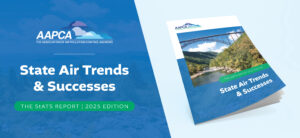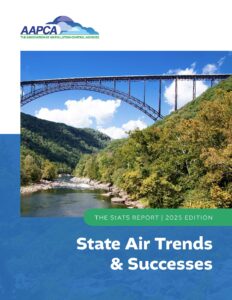
AAPCA Publishes 2025 Edition of State Air Trends & Success: The StATS Report
State and local air agencies driving sustained reductions in air pollution
May 9, 2025
Lexington, KY
This morning, the Association of Air Pollution Control Agencies (AAPCA) released the 2025 edition of State Air Trends & Successes: The StATS Report. In the ninth year of publication, the Association’s report spotlights state and local air agencies as essential to the significant improvement in air quality that has been achieved in the United States since the enactment of the Clean Air Act in 1970. The 2025 edition is being released in celebration of Air Quality Awareness Week, from May 5 to 9.
“As The StATS Report shows, state and local air agencies continue to meet the mission of reducing air pollution and protecting public health,” stated AAPCA President Laura Crowder, Director for the West Virginia Division of Air Quality. “We take pride in the continued success of efforts to enhance air quality across the United States.”
The StATS Report catalogues key trends and metrics that are publicly available from federal, state, and local agencies, and includes data for criteria air pollutant concentrations and emissions, hazardous air pollutants (or air toxics), energy-related carbon dioxide, and visibility in national parks. Where applicable for context, trends for economic and social indicators like Gross Domestic Product, energy production, and population are included. The report is divided into sections on “AAPCA Member State Air Trends & Successes,” “American Air Quality in an International Context,” and “Air Quality Trends in the United States.”
Commenting on the report, AAPCA Vice President Jim Boylan, Chief of the Georgia Air Protection Branch, noted that “AAPCA’s members are responsible for and dedicated to ensuring the availability of quality data used to drive science-based policies, regulatory decisions, and best practices.”
A few national trends from the 2025 edition of State Air Trends & Successes: The StATS Report include:
- From 1970 to 2023, the United States has reduced aggregate emissions of criteria air pollutants under the National Ambient Air Quality Standards (NAAQS) programs by 78 percent.
- Wildfires and miscellaneous sources make up the majority of particulate matter (PM) emissions in the United States, contributing an estimated 68 percent of PM5 emissions and 86 percent of PM10 emissions in 2024.
- From 1995 to 2023, the United States has reduced sulfur dioxide (SO₂), nitrogen oxides (NOX), and carbon dioxide (CO2) emissions from power plants by 96 percent, 90 percent, and 28 percent, respectively.
- On average from 2000 to 2022, visibility in national parks and wilderness areas improved by 37 percent on the 20 percent clearest days, and 29 percent on the 20 percent most impaired days.
The StATS Report also showcases AAPCA Member leadership:
- Collectively from 2000 to 2024, AAPCA Member States have reduced aggregate emissions of criteria air pollutants by an estimated 44 percent.
- From 2000 to 2022, AAPCA Members States achieved a 15 percent decrease in energy-related carbon dioxide (CO₂) emissions, while energy production increased by 55 percent. For the same period, AAPCA’s membership oversaw an average 44 percent reduction in carbon intensity of the economy.
- From 2013 to 2023, reported toxic air releases in the United States declined by 33 percent and AAPCA Member States were responsible for about 68 percent of the total reduction.
Case studies featured in the 2025 edition of The StATS Report include:
- A regional haze case study of the Georgia Cohutta Wilderness Area, which is currently more than 20 years ahead of schedule to meet uniform rate of progress (URP) targets under the regional haze program.
- Two local program case studies detailing San Joaquin Valley’s achievements in reducing fine particulate matter concentrations in Central California, as well as the significant reductions in toxic air contaminants in Louisville, Kentucky accomplished by the Strategic Toxic Air Reduction (STAR) program.
The 2025 edition of AAPCA’s State Air Trends & Successes: The StATS Report is available at: https://cleanairact.org/wp-content/uploads/2025/05/AAPCA_2025_StATS_Report_FINAL_for-distribution.pdf
The U.S. Environmental Protection Agency (EPA) hosts Air Quality Awareness Week (#AQAW2025) with federal partners and state, local, and tribal agencies. The 2025 theme is “Stay Air Aware,” with the following daily topics: Wildland Fires and Smoke; Asthma and Your Health; Indoor Air Quality; and Air, Animals, and Plants. More information about AQAW can be found here.
AAPCA Background
The Association of Air Pollution Control Agencies (AAPCA) is a national, non-profit, consensus-driven organization focused on assisting state and local air quality agencies and personnel with implementation and technical issues associated with the federal Clean Air Act. AAPCA represents 53 state and local air pollution control agencies, and senior officials from 21 state environmental agencies currently sit on the AAPCA Board of Directors. AAPCA is housed in Lexington, Kentucky as an affiliate of The Council of State Governments. You can find more information about AAPCA at: www.cleanairact.org.
Association of Air Pollution Control Agencies | 1776 Avenue of the States | Lexington, Kentucky 40511
www.cleanairact.org | @AAPCA_States | LinkedIn
Contact: Morgan Dickie, Executive Director (mdickie@csg.org / 859-244-8043)
